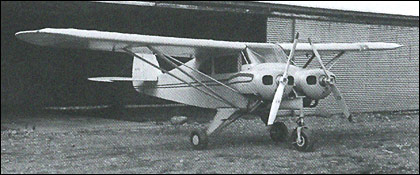|
| There is no text information for this aircraft at the moment.
| Graham Clayton, e-mail, 21.02.2022 11:41 I don't think Harold Wagner pushed the envelope - he shredded it into a million pieces! reply | | IsaacElton, e-mail, 05.08.2015 17:32 My father owned this PA-22 after the conversion back to single engine. Tail Number N932A. I am looking for more photographs of the aircraft for him (he is not computer savvy.) Any replies or my email is IsaacElton at gmail dot com.
Thanks,
Isaac Elton reply | | deaftom, e-mail, 12.04.2011 05:56 And then there was Charles Rhoades' Twin Piper or Twin Cub, circa 1965, which consisted of two Piper Cub fuselages joined along one side, sharing one set of wings, the two original fins, a common center horizontal stabilizer plus standard outer stabilizers and elevators, and the standard two engine installations, though one prop shaft had to have a spacer added so its prop arc could overlap the other's without hitting each other. The Nelson Engine Corporation acquired the design rights, but apparently it went no further. Another cul-de-sac, as Barry would say. reply | | Bill Johnston, e-mail, 25.03.2011 19:19 As a pilot who began flying over 50 years ago, I remember these Twin experiments of Mr Wagner very well. For those lucky enough to still have a copy of "Americas forgotten Wings", page 92, Volumn 1, published in 1994, you can read all about this subject. It is indeed an interesting piece of Civil Aviation development from the Glory days of Aviation. Hope this helps to bring back memories for many of you Aviation enthusiasts. Keep Flying, Bill J. reply | |
| | Barry, 30.06.2010 16:08 Designed by Harold Wagner this aircraft was in effect a standard Piper Tri Pacer with an extra (Lycoming) engine added. It followed a similar conversion of a Piper Cub. The selling point was that a customer could have a twin engine aircraft at "50% lower cost" but at the end of the day the accomodation remained the same, or in the case of the Cub, even less. The idea was never developed beyond the prototypes and the aircraft were returned to their normal situation and so that was that;another cul de sac in the development of aviation. reply |
|
Do you have any comments?
|
| |









